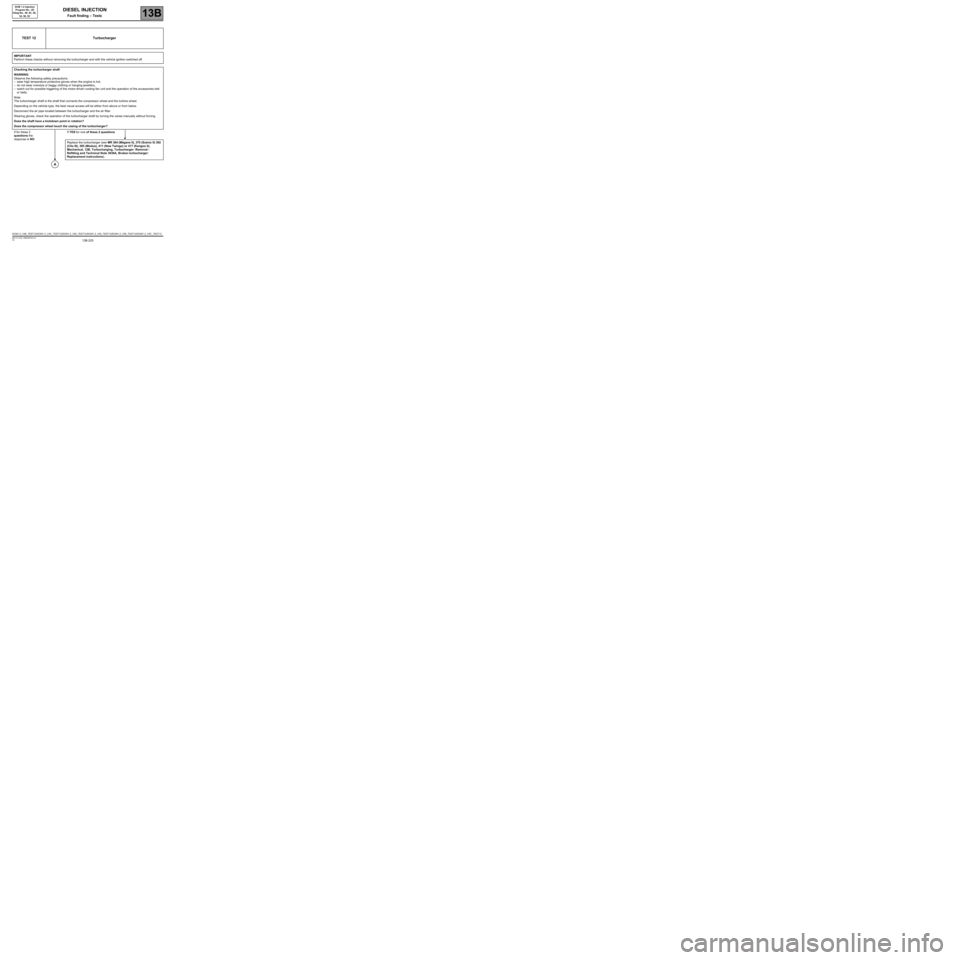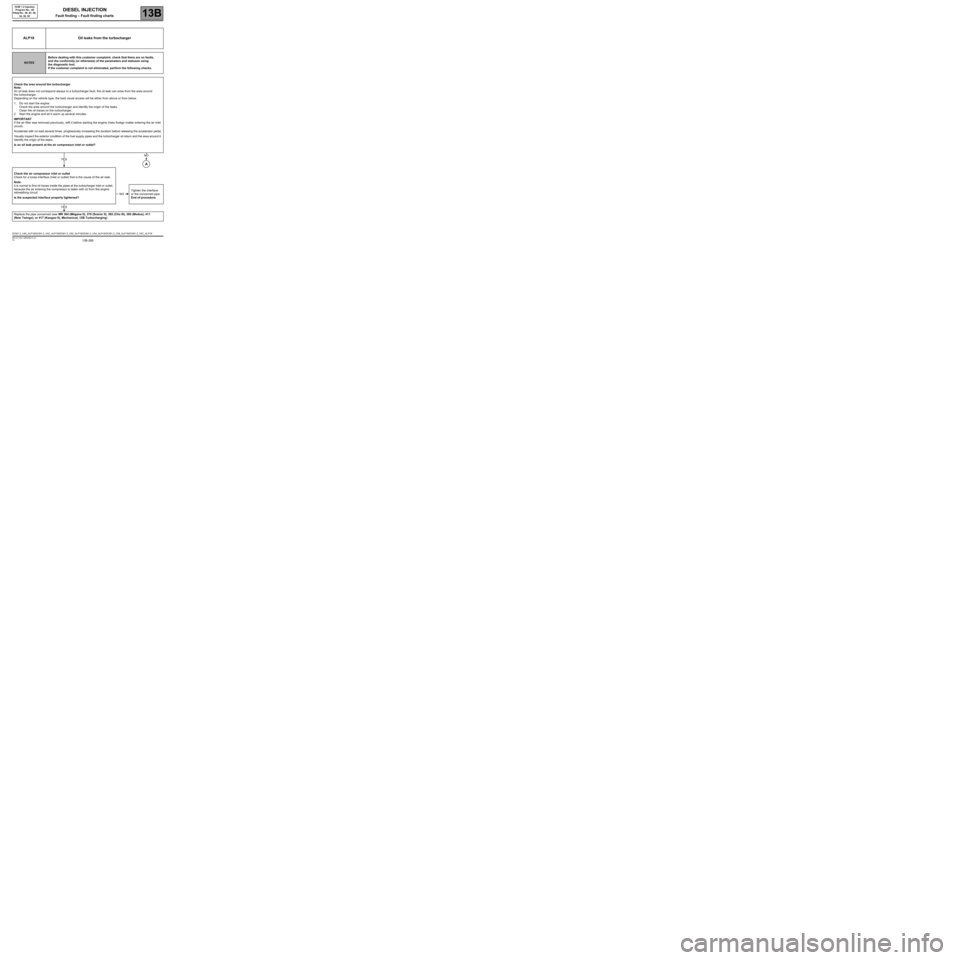2009 RENAULT TWINGO RS air filter
[x] Cancel search: air filterPage 223 of 269

13B-223V6 MR-413-X44-13B000$190.mif
DIESEL INJECTION
Fault finding – Tests13B
DCM 1.2 Injection
Program No.: 4D
Vdiag No.: 48, 4C, 50,
54, 58, 5C
TEST 11 Air line at the turbocharger
Check that the air filter is present.
Check the replacement interval of the air filter on the maintenance booklet.
Compare the part nos. of the fitted air filter on the vehicle and of the air filter recommended by the manufacturer.
Check the direction of fitting of the air filter.
Is the air filter correctly fitted on the vehicle?
Check the condition of the air filter
Visually inspect the condition of the filtering section of the air
filter.
Is the air filter or its seal damaged?
Is the air filter fouled (does it contain a lot of impurities)?Replace the air filter (see MR 364
(Mégane II), 370 (Scénic II), 392
(Clio III), 385 (Modus), 411
(New Twingo) or 417 (Kangoo II)
Mechanical, 12A, Fuel mixture,
Air filter, Removal - Refitting).
Low pressure circuit check
Note:
Depending on the vehicle type, the best visual access will be
either from above or from below.
Visually inspect the condition of the following components:
–fresh air inlet scoop on the front panel of the vehicle,
–air inlet pipe to the air filter,
–air pipe of the filter up to the compressor inlet,
–air flowmeter mountings.
Is one of these components incorrect (pipes dislodged,
torn, bent, pierced or kinked)?Replace the faulty parts (see MR
364 (Mégane II), 370 (Scénic II)
392 (Clio III), 385 (Modus), 411
(New Twingo) or 417 (Kangoo II),
Mechanical, 12B,
Turbocharging).
YESNO
YES
NO
YES
NO
A
DCM1.2_V48_TEST11/DCM1.2_V4C_TEST11/DCM1.2_V50_TEST11/DCM1.2_V54_TEST11/DCM1.2_V58_TEST11/DCM1.2_V5C_TEST11
Page 225 of 269

13B-225V6 MR-413-X44-13B000$190.mif
DIESEL INJECTION
Fault finding – Tests13B
DCM 1.2 Injection
Program No.: 4D
Vdiag No.: 48, 4C, 50,
54, 58, 5C
TEST 12 Turbocharger
IMPORTANT
Perform these checks without removing the turbocharger and with the vehicle ignition switched off.
Checking the turbocharger shaft
WARNING
Observe the following safety precautions:
–wear high temperature protective gloves when the engine is hot,
–do not wear oversize or baggy clothing or hanging jewellery,
–watch out for possible triggering of the motor-driven cooling fan unit and the operation of the accessories belt
or belts.
Note:
The turbocharger shaft is the shaft that connects the compressor wheel and the turbine wheel.
Depending on the vehicle type, the best visual access will be either from above or from below.
Disconnect the air pipe located between the turbocharger and the air filter.
Wearing gloves, check the operation of the turbocharger shaft by turning the vanes manually without forcing.
Does the shaft have a kickdown point in rotation?
Does the compressor wheel touch the casing of the turbocharger?
If for these 2
questions the
response is NOIf YES for one of these 2 questions
Replace the turbocharger (see MR 364 (Mégane II), 370 (Scénic II) 392
(Clio III), 385 (Modus), 411 (New Twingo) or 417 (Kangoo II),
Mechanical, 12B, Turbocharging, Turbocharger: Removal -
Refitting and Technical Note 3938A, Broken turbocharger:
Replacement instructions).
A
DCM1.2_V48_TEST12/DCM1.2_V4C_TEST12/DCM1.2_V50_TEST12/DCM1.2_V54_TEST12/DCM1.2_V58_TEST12/DCM1.2_V5C_TEST12
Page 230 of 269

13B-230V6 MR-413-X44-13B000$190.mif
DIESEL INJECTION
Fault finding – Tests13B
DCM 1.2 Injection
Program No.: 4D
Vdiag No.: 48, 4C, 50,
54, 58, 5C
TEST 13 Diesel fuel conformity check
WARNING
During this operation, it is essential to:
–refrain from smoking or bringing incandescent objects close to the work area,
–protect yourself against fuel splashes due to residual pressure in the pipes,
–wear safety goggles with side guards,
–wear leaktight gloves (Nitrile type).
IMPORTANT
–To avoid any corrosion or damage, protect the areas on which fuel is likely to run.
–To prevent impurities from entering the circuit, place protective plugs on all fuel circuit components
exposed to the open air.
Preparations:
Weigh an empty 1300 ml plastic cup (part no. 77 11 171 413) with its cover (part no. 77 11 171 416) using an
electronic scale similar to those used in body paint workshops (for example: PANDA part no. 77 11 224 995).
Record the weight of the empty cup.
This type of plastic cup is used to prepare paint.
Take a 1 l fuel sample from the diesel fuel filter outlet (see MR 364 (Mégane II) or MR 370 (Scénic II), MR 385
(Modus), MR 392 (Clio III), MR 411 (New Twingo), MR 417 (Kangoo 2), Mechanical, 19C, Tank, Fuel tank
draining), using a pneumatic transfer pump (part no. 634-200) and place it in the 1300 ml plastic cup.
Cover the plastic cup with its cover and let it settle for approximately2 minutes.
Is the fuel cloudy or does it
separate into two parts?The diesel fuel contains water and is not compliant.
Drain the fuel circuit, including the tank (see MR 364 (Mégane II)
or MR 370 (Scénic II), MR 385 (Modus), MR 392 (Clio III), MR 411
(New Twingo), MR 417 (Kangoo 2), Mechanical, 19C, Tank, Fuel
tank drain).
YES
NO
A
DCM1.2_V48_TEST13/DCM1.2_V4C_TEST13/DCM1.2_V50_TEST13/DCM1.2_V54_TEST13/DCM1.2_V58_TEST13/DCM1.2_V5C_TEST13
Page 243 of 269

13B-243V6 MR-413-X44-13B000$210.mif
DIESEL INJECTION
Fault finding – Fault finding charts13B
DCM 1.2 Injection
Program No.: 4D
Vdiag No.: 48, 4C, 50,
54, 58, 5C
ALP4
CONTINUED
Control the injectors using the commands:
–AC005 Cylinder 1 injector,
–AC006 Cylinder 2 injector,
–AC007 Cylinder 3 injector,
–AC008 Cylinder 4 injector.
Can you hear the valve moving when you are 1 metre
from the vehicle?Run Test 9 Diesel filter check.
If test 9 is correct, replace only the faulty
injector(s) (see MR 364 (Mégane II), MR 370
(Scénic II), MR 385 (Modus), MR 392
(Clio III), MR 411 (New Twingo), MR 417
(Kangoo 2), Mechanical, 13B, Diesel
injection, Diesel injector: Removal -
Refitting).
Check the high pressure system: run TEST 6 High pressure system check.
Check the computer:
Check that the computer connectors are properly locked.
Check the condition of the computer connections (bent pin, signs of corrosion, silicone, etc.).
If the connector(s) is faulty and if there is a repair procedure (see Technical Note 6015A, Repairing electrical
wiring, Wiring: Precautions for repair), repair the connector, otherwise replace the wiring.
Contact the Techline if the customer complaint is still present.
A
NO
YES
Page 252 of 269

13B-252V6 MR-413-X44-13B000$210.mif
DIESEL INJECTION
Fault finding – Fault finding charts13B
DCM 1.2 Injection
Program No.: 4D
Vdiag No.: 48, 4C, 50,
54, 58, 5C
ALP10
CONTINUED
The vehicle has entered the "Flow capacity function"
program. This function is activated more easily when:
the external temperature is high, the fuel level in the
tank is at 1/4, the vehicle is laden and if the vehicle
speed is high. Check the high pressure pump: run TEST 6
High pressure system check.
Is the "Flow capacity function"
programming active?
Check the computer:
Check that the computer connectors are
properly locked.
Check the condition of the computer
connections (bent pin, signs of corrosion,
silicone, etc.).
If the connector(s) is faulty and if there is
a repair procedure (see Technical Note
6015A, Repairing electrical wiring, Wiring:
Precautions for repair), repair the connector,
otherwise replace the wiring.Check the diesel filter.
Has the diesel fuel filter reached its full mileage?
Contact the Techline if the customer complaint
is still present.
Replace the diesel filter (see MR 364 (Mégane II),
MR 370 (Scénic II), MR 385 (Modus), MR 392
(Clio III), MR 411 (New Twingo), MR 417
(Kangoo 2), Mechanical, 13A, Fuel mixture, Fuel
filter: Removal - Refitting).
Contact the Techline if the customer complaint is still
present.
A
YES
NO
YES
Page 253 of 269

13B-253V6 MR-413-X44-13B000$210.mif
DIESEL INJECTION
Fault finding – Fault finding charts13B
DCM 1.2 Injection
Program No.: 4D
Vdiag No.: 48, 4C, 50,
54, 58, 5C
In this case, the lack of power is due to insufficient vacuum for the OCR * setpoint given.
ALP11 Loss of power
NOTESSpecial note:
Only consult this customer complaint after a complete check with the diagnostic tool.
See explanation for flow capacity function in system operation.
There is no turbocharging control solenoid valve on New Twingo K9K 740
engines or on Kangoo 2 K9K 800 engines.
Is the "Flow capacity function" programming
active?Check the diesel filter.
Is it close to the replacement mileage?
Using the diagnostic tool, check that the injector
codes (C2I) are correctly entered on the identification
screen. If not, configure the correct injector codes
using command SC002 Enter injector codes.Replace the diesel filter (see MR 364
(Mégane II), MR 370 (Scénic II), MR 385
(Modus), MR 392 (Clio III), MR 411
(New Twingo), MR 417 (Kangoo 2),
Mechanical, 13A, Fuel mixture, Fuel
filter: Removal - Refitting).
Check the air inlet circuit: run TEST 5 Air inlet circuit
check.
YES
NO
NO
YES
A
DCM1.2_V48_ALP11/DCM1.2_V4C_ALP11/DCM1.2_V50_ALP11/DCM1.2_V54_ALP11/DCM1.2_V58_ALP11/DCM1.2_V5C_ALP11
Page 268 of 269

13B-268V6 MR-413-X44-13B000$210.mif
DIESEL INJECTION
Fault finding – Fault finding charts13B
DCM 1.2 Injection
Program No.: 4D
Vdiag No.: 48, 4C, 50,
54, 58, 5C
ALP18 Oil leaks from the turbocharger
NOTESBefore dealing with this customer complaint, check that there are no faults,
and the conformity (or otherwise) of the parameters and statuses using
the diagnostic tool.
If the customer complaint is not eliminated, perform the following checks.
Check the area around the turbocharger
Note:
An oil leak does not correspond always to a turbocharger fault, the oil leak can arise from the area around
the turbocharger.
Depending on the vehicle type, the best visual access will be either from above or from below.
1. Do not start the engine.
Check the area around the turbocharger and identify the origin of the leaks.
Clean the oil traces on the turbocharger.
2. Start the engine and let it warm up several minutes.
IMPORTANT
If the air filter was removed previously, refit it before starting the engine (risks foreign matter entering the air inlet
circuit).
Accelerate with no load several times, progressively increasing the duration before releasing the accelerator pedal.
Visually inspect the exterior condition of the fuel supply pipes and the turbocharger oil return and the area around it.
Identify the origin of the leaks.
Is an oil leak present at the air compressor inlet or outlet?
Check the air compressor inlet or outlet
Check for a loose interface (inlet or outlet) that is the cause of the air leak.
Note:
It is normal to find oil traces inside the pipes at the turbocharger inlet or outlet,
because the air entering the compressor is laden with oil from the engine
rebreathing circuit.
Is the suspected interface properly tightened?Tighten the interface
or the concerned pipe.
End of procedure.
Replace the pipe concerned (see MR 364 (Mégane II), 370 (Scénic II), 392 (Clio III), 385 (Modus), 411
(New Twingo), or 417 (Kangoo II), Mechanical, 12B Turbocharging).
YES
NO
A
NO
YES
DCM1.2_V48_ALP18/DCM1.2_V4C_ALP18/DCM1.2_V50_ALP18/DCM1.2_V54_ALP18/DCM1.2_V58_ALP18/DCM1.2_V5C_ALP18